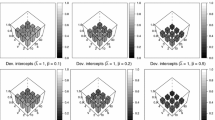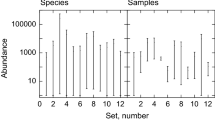Abstract
In biological and ecological statistical inference, it is practically useful to provide a lower bound for species richness in a community. Chao (1984, 1989) derived a non-parametric lower bound for species richness in a single community. However, there have been no lower bounds proposed in the literature for the number of species shared by multiple communities. Based on sample species abundance or replicated incidence records from each of the N communities, we derive in this article a nonparametric approach to constructing a lower bound for the number of species shared by N (N≥2) communities. The approach is valid for all types of species abundance distributions (for abundance data) or species detection probabilities (for replicated incidence data). Variance estimators for the proposed lower bounds are obtained by using typical asymptotic theory. Simulation results are reported to examine the performance of the lower bounds. Replicated incidence data of ciliate species collected in three areas from Namibia, southwest Africa, are used for illustration. We also briefly discuss the application of the proposed method to estimate the size of a shared population (i.e., the number of individuals in the intersection of multiple populations) based on capture-recapture data from each population.
Similar content being viewed by others
References
Bohannan, B. J. M., and Hughes, J. (2003), “New Approaches to Analyzing Microbial Biodiversity Data,” Current Opinion in Microbiology, 6, 182–187.
Boulinier, T., Nichols, J. D., Sauer, J. R., Hines, J. E., and Pollock, K. H. (1998), “Estimating Species Richness: The Importance of Heterogeneity in Species Detectability,” Ecology, 79, 1018–1028.
Bunge, J., and Fitzpatrick, M. (1993), “Estimating the Number of Species: A Review,” Journal of the American Statistical Association, 88, 364–373.
Chao, A. (1984), “Nonparametric Estimation of the Number of Classes in a Population,” Scandinavian Journal of Statistics, 11, 265–270.
— (1987), “Estimating the Population Size for Capture-Recapture Data With Unequal Catchability,” Biometrics, 43, 783–791.
— (1989), “Estimating Population Size for Sparse Data in Capture-Recapture Experiments,” Biometrics, 45, 427–438.
— (2005), “Species Estimation and Applications,” in Encyclopedia of Statistical Sciences, Vol. 12 (2nd ed.), eds. N. Balakrishnan, C. B. Read, and B. Vidakovic, New York: Wiley, pp. 7907–7916.
Chao, A., and Shen, T. J. (2003), Program SPADE (Species Prediction And Diversity Estimation), program and user’s guide at http://chao.stat.nthu.edu.tw.
Chao, A., Hwang, W.-H., Chen, Y.-C., and Kuo, C.-Y. (2000), “Estimating the Number of Shared Species in Two Communities,” Statistica Sinica, 10, 227–246.
Chao, A., Li, P. C., Agatha, S., and Foissner, W. (2006), “A Statistical Approach to Estimate Soil Ciliate Diversity and Distribution Based on Data From Five Continents,” Oikos, 114, 479–493.
Chao, A., Pan, H. Y., and Chiang, S. C. (2008), “The Petersen-Lincoln Estimator and Its Extension to Estimate the Size of a Shared Population,” Biometrical Journal, 50, 957–970.
Chao, A., Shen, T.-J., and Hwang, W.-H. (2006), “Application of Laplace’s Boundary-Mode Approximations to Estimate Species and Shared Species Richness,” Australian and New Zealand Journal of Statistics, 48, 117–128.
Colwell, R. K. (2004), EstimateS: Statistical Estimation of Species Richness and Shared Species From Samples, Version 7.5, user’s guide and application published at http://viceroy.eeb.uconn.edu/estimates.
Colwell, R. K., and Coddington, J. A. (1994), “Estimating Terrestrial Biodiversity Through Extrapolation,” Philosophical Transactions of the Royal Society of London B—Biological Sciences, 345, 101–118.
Fisher, R. A., Corbet, A. S., and Williams, C. B. (1943), “The Relation Between the Number of Species and the Number of Individuals in a Random Sample of an Animal Population,” Journal of Animal Ecology, 12, 42–58.
Foissner, W. (1999), “Protist Diversity: Estimates of the Near Imponderable,” Protist, 150, 363–368.
— (2006), “Biogeography and Dispersal of Micro-Organisms: A Review Emphasizing Protists,” Acta Protozoologica, 45, 111–136.
Foissner, W., Agatha, S., and Berger, H. (2002), “Soil Ciliates (Protozoa, Ciliophora) From Namibia (Southwest Africa), With Emphasis on Two Contrasting Environments, the Etosha Region and the Namib Desert,” Denisia, 5, 1–1459.
Green, J., Holmes, A. J., Westoby, M., Oliver, I., Brlscoe, D., Dangerfield, M., Gillings, M., and Beattle, A. J. (2004), “Spatial Scaling of Microbial Eukaryote Diversity,” Nature, 432, 747–753.
Hillebrand, H., Watermann, F., Karez, R., and Berninger, U.-G. (2001), “Differences in Species Richness Patterns Between Unicellular and Multicellular Organisms,” Oecologia, 126, 114–124.
Hughes, J. B., Hellmann, J. J., Ricketts, T. H., and Bohannan, B. J. M. (2001), “Counting the Uncountable: Statistical Approaches to Estimating Microbial Diversity,” Applied and Environmental Microbiology, 67, 4399–4406.
MacArthur, R. H. (1957), “On the Relative Abundances of Bird Species,” Proceedings of the National Academy of Sciences, 43, 193–295.
Magurran, A. E. (2004), Measuring Biological Diversity, Oxford, U.K.: Blackwell.
Schloss, P. D., and Handelsman, J. (2005), “Introducing DOTUR, a Computer Program for Defining Operational Taxonomic Units and Estimating Species Richness,” Applied and Environmental Microbiology, 71, 1501–1506.
Seber, G. A. F. (1982), The Estimation of Animal Abundance (2nd ed.), London: Griffin.
Stach, J. E. M., Maldonado, L. A., Masson, D. G., Ward, A. C., Goodfellow, W. M., and Bull, A. T. (2003), “Statistical Approaches for Estimating Actinobacterial Diversity in Marine Sediments,” Applied Environmental Microbiology, 69, 6189–6200.
Turner, W., Leitner, W., and Rosenzweig, M. L. (1999), WS2m: Software for Estimating Diversity, program and user’s guide at http://eebweb.arizona.edu/diversity.
Walther, B. A., and Morand, S. (1998), “Comparative Performance of Species Richness Estimation Methods,” Parasitology, 116, 395–405.
Author information
Authors and Affiliations
Corresponding author
Rights and permissions
About this article
Cite this article
Pan, H.Y., Chao, A. & Foissner, W. A nonparametric lower bound for the number of species shared by multiple communities. JABES 14, 452–468 (2009). https://doi.org/10.1198/jabes.2009.07113
Received:
Revised:
Issue Date:
DOI: https://doi.org/10.1198/jabes.2009.07113




